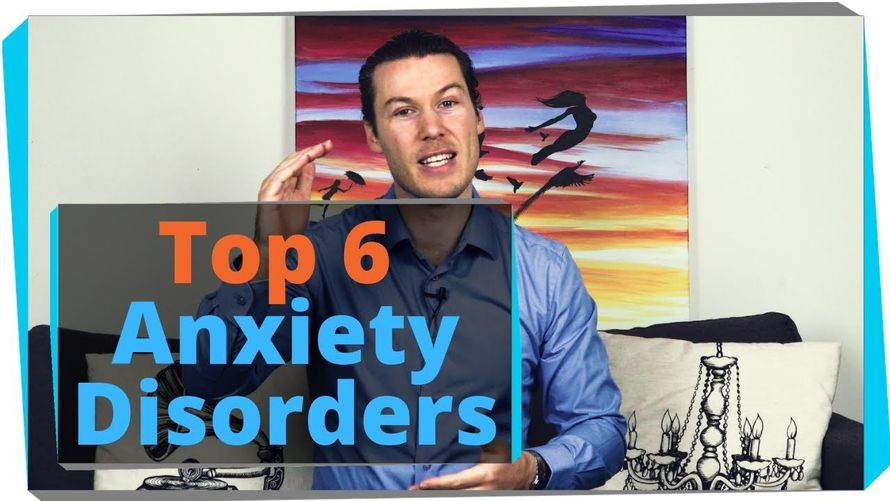Anxiety Disorders: How likely am I to get one? (The Top 6)

Today I’ll cover the top 6 most common anxiety disorders.
I’m Michael Burrows, I’m a clinical psychologist and have been specialising in anxiety disorders for the past 6 years.
I’m going to talk about the types of anxiety you are most likely to be diagnosed with. And at the end I’ll share with you what I noticed was the most diagnosed anxiety disorder when I was working in a district health board team and I’ll tell you how likely it is to get any anxiety disorder in your lifetime.
(If you'd prefer to watch rather than read, you can see this in video form below)
Now, I want to note that when I say anxiety disorder, I’m meaning an anxiety condition, or collection of symptoms, which are significantly impacting on your functioning. Anxiety may be interfering with your work, making it hard to enjoy your leisure time, or making it difficult to socialise.
There are going to be others who experience anxiety, but would not be diagnosed as having a disorder - it is odd in the extreme for a human to have no anxiety about anything. We all have adrenal systems!
Alright, number 6 is OCD, Obsessive-Compulsive Disorder. This is when you have recurrent unwanted thoughts, or “obsessions”, along with repetitive behaviours, “compulsions”.
Compulsions, e.g. Handwashing, or checking (“Did I turn those lights off?”, “Is my stove still on?”) are done in hope of nullifying or preventing the thoughts and associated discomfort, but only provides temporary relief. However, trying not to do these ramps anxiety up.
You have a 2.3% likelihood of experiencing the above collection of symptoms at some point in your life, though this becomes less likely the older you get. If you are experiencing these, you most likely would have had less severe versions of these thoughts from when you were younger. You may have avoided cracks in the pavement, or counted in your head as a form of compulsive behaviour.
The interesting thing about OCD is that research shows that pretty much everyone experiences the unwanted thoughts, like, “What if I pushed that person off this cliff?”, or “What if I’m a pedophile?”. What differentiates people with OCD, is that they are anxious about these thoughts and try to prevent them, while most people go, “well that was weird. Oh well!” and the thought drifts off.
Number 5! Panic disorder.
With this disorder, as you might expect you get lots of Panic attacks - Unexpected and repeated episodes of intense fear, along with physical symptoms, like chest pain, heart palpitations and shortness of breath.
Fear of these leads to avoidance of activities or places in order to avoid the symptoms. In the extreme, this can lead to agoraphobia, which is where it becomes difficult to leave your house.
Your chance of Panic disorder is 4.7%. So if you lived 20 lives, you would likely have panic disorder during one of them. Or if you know 20 people, 1 of them would statistically be likely to have a panic disorder at some point.
Next up, number 4!
Which is… Generalised Anxiety Disorder.
People with this experience almost constant anxiety, exaggerated worry and tension. This comes with a 5.7% likelihood.
And, number 3 - PTSD! Post-Traumatic Stress Disorder, which is what Becky is going through at the moment.
PTSD comes from exposure to a terrifying event during which you felt very threatened. Your memory of this event can then be triggered repeatedly by things that remind you of the event. This causes a partial or full reliving of the event - or a “flashback”.
Now, there is Complex PTSD as well, but that’s beyond the scope of this video, so we’re just talking about one-off classical trauma here. Which you have a 6.6% likelihood of experiencing.
Sadly, 50% of us will experience at least 1 traumatic event in our lives. The good news is that most of the time, this will not lead to the development of PTSD. Which is considered by some to be a memory disorder. Involving a different storage of the memory of the event and having difficulty seeing it as being in the past. So it feels like it’s happening again now, in the present, causing intense anxiety while being safe from the past danger.
Now, the second most common type of anxiety: Social Anxiety disorder.
This involves an overwhelming sense of anxiety and self-consciousness in social situations. You may experience this anxiety in a broad array of social situations, or only in specific ones (for example, eating in public).
Or you may have the performance subtype, where you only experience anxiety in performance situations, like public speaking, presenting at work, or in class.
Social anxiety disorder carries a whopping 12.1% likelihood. So if you put 25 people in a room, just over 3 of them could be diagnosed with social anxiety at some point in their lives. Now remember, this is at disorder-level. There are more than this who experience some anxiety in social situations.
And, the one you’ve been waiting for!
The number 1 most common anxiety disorder is… Specific Phobia!
An intense fear about a particular object or situation. These all come with fancy Latin names ending in phobia, like Claustrophobia, one of the most common: fear of tight or constricted spaces. Other common ones are fear of flying, spiders, driving, vomiting and blushing.
You are 12.5% likely to develop a phobia during your lifetime.
I do think it’s a bit of cheat having this as number one, as it includes a whole bunch of different fears. That said, they follow the same patterns of thoughts and behaviour, which is the important thing when classifying disorders. As the main reason you want a classification is for knowing how best to treat it.
I will now tell you the anxiety disorder I found was the most common anxiety diagnosis given when I was working in a district health board team.
This was, Anxiety disorder NOS. No, not anxiety about Nitrous Oxide. Anxiety Disorder Not Otherwise Specified.
This diagnosis is used when someone has severe enough anxiety to warrant being diagnosed with a condition, but don’t meet the full criteria for any single condition. For example to meet the criteria for PTSD you need to meet criterion A through H. If you only meet criterion B, D and F, then you couldn’t get a PTSD diagnosis.
If you had a few symptoms from PTSD and a few from Social anxiety, but not enough to meet the criteria from either, then you could still get Anxiety Disorder NOS. It’s a bit of a catch-all, but those can be important, so people can access the help they need.
Alright! We’ve covered the top 6 most common anxiety disorders: OCD, Panic, Generalised anxiety, PTSD, Social anxiety, and Specific phobias, plus the bonus; Anxiety Disorder NOS.
Now, as promised, I will tell you the overall likelihood of getting an anxiety disorder in your lifetime. According to large population-based research, 33.7% of us will get an anxiety disorder at some point in our lives. That’s a third of us!
You may be thinking, “Michael, all of the disorders you mentioned earlier add up to more than 33.7!”. The thing is though, anxiety disorders are commonly co-morbid (it’s common to have more than one).
The most likely of them to cross-credit is Agoraphobia. Which is most commonly co-morbid with Social anxiety disorder, then Panic disorder, then with a Specific phobia.
I want to say, all of these disorders are treatable.
The longer you’ve had it for, the more embedded the thinking patterns that maintain the disorder, so, usually, the longer treatment will be. But in my experience all very treatable with effective psychological treatment.
If you or someone you know is struggling with anxiety, please do seek help from an experienced professional. Most sufferers do not seek treatment, but for those who do, it can have a huge positive impact on their lives.










